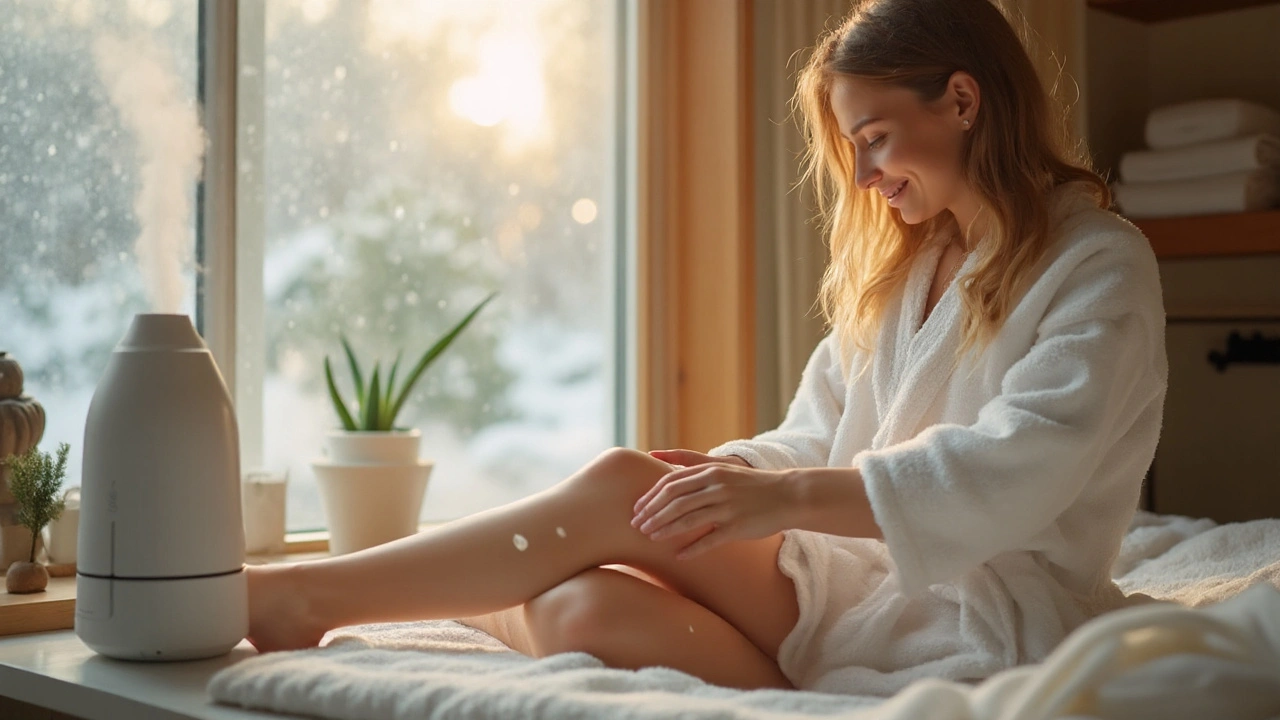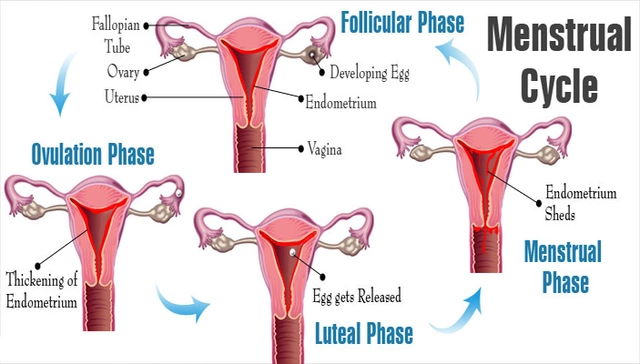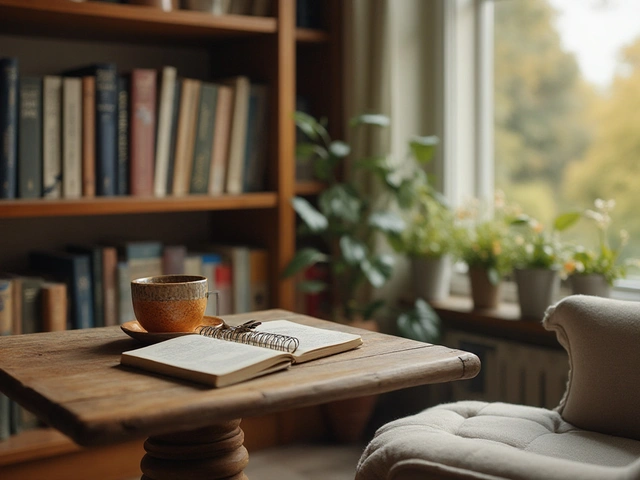Winter Care Guide for Managing Plaque Psoriasis

- Colin Hurd
- 22 September 2025
- 12 Comments
Plaque Psoriasis is a chronic inflammatory skin condition characterized by thick, silvery scales that often flare up in colder months. When the temperature drops, the skin loses moisture faster, the immune response can spike, and flare‑ups become more common. This guide walks you through the science behind winter‑related flare‑ups and hands you a toolbox of proven tactics so you can stay comfortable until spring arrives.
Why Winter Triggers Psoriasis
Three main forces make winter a rough season for psoriasis sufferers:
- Low humidity dries out the stratum corneum, weakening the skin barrier and making it easier for immune cells to infiltrate.
- Cold air often encourages indoor heating, which further reduces ambient Humidity to 20-30% relative humidity.
- Seasonal stressors - holidays, shorter daylight hours, and the urge to stay indoors - can raise cortisol levels, a known psoriasis trigger.
Understanding these drivers helps you target the right interventions.
Build a Winter‑Proof Skincare Routine
Start with the basics: cleanse, moisturize, protect. Each step can be fine‑tuned for the colder climate.
1. Choose the Right Cleanser
Opt for fragrance‑free, non‑soap cleansers that maintain the skin’s natural pH (around 5.5). Avoid hot water - 98°F (37°C) is enough to rinse without stripping lipids.
2. Moisturizer Matters
Moisturizer is the cornerstone of winter psoriasis care. Look for products that combine occlusive agents (petrolatum, dimethicone) with humectants (glycerin, hyaluronic acid). Apply while the skin is still damp to lock in water.
3. Targeted Topical Treatments
When dry patches persist, add prescription‑strength agents:
- Topical Corticosteroid - reduces inflammation quickly; use the lowest potency that controls the flare.
- Vitamin D Analog (e.g., calcipotriene) - slows skin cell production and works well with steroids in a “combo” regimen.
Apply these after the moisturizer so the barrier isn’t compromised.
Comparing Moisturizer Types
| Type | Occlusiveness | Greasy Feel | Best For |
|---|---|---|---|
| Cream | Medium | Low‑Medium | Daytime use, normal‑dry skin |
| Ointment | High | High | Severe dryness, night‑time barrier repair |
| Lotion | Low | Low | Acne‑prone or oily areas (e.g., scalp) |
| Bath Oil | Medium‑High | Medium | Pre‑shower barrier boost |
For most winter flare‑ups, an ointment applied after a quick shower gives the best lock‑in effect. Keep a small sachet of cream in your bag for on‑the‑go touch‑ups.
Environmental Tweaks to Raise Indoor Humidity
Simple changes can raise indoor Humidity to a psoriasis‑friendly 40-50%:
- Run a cool‑mist humidifier in bedrooms and living areas. Aim for 30‑45 minutes per session.
- Place water‑filled bowls near radiators or heating vents - the evaporating water adds moisture without electricity.
- Air‑dry laundry indoors on rainy days; the damp clothes release moisture slowly.
- Avoid direct heat blasts from hair dryers, which can further dehydrate skin.
Monitor humidity with a cheap digital hygrometer; adjust the humidifier accordingly.

Adjunct Therapies for Winter Management
Beyond skincare, several medical and lifestyle options can keep flare‑ups at bay.
Phototherapy
Phototherapy - controlled exposure to UVB light - remains effective when sunlight is scarce. Narrow‑band UVB units at dermatology clinics can be scheduled twice weekly during the cold season. Studies from the Australian Dermatology Association show a 60% reduction in PASI score after a 12‑week course.
Systemic Options
For moderate‑to‑severe cases, oral retinoids, methotrexate, or biologics (e.g., IL‑17 inhibitors) may be prescribed. These are not winter‑specific but can smooth out seasonal spikes when topical measures fall short.
Stress‑Reduction Techniques
Since cortisol can ignite inflammation, incorporate stress‑busting habits:
- 30‑minute brisk walk three times a week - fresh air, endorphins, and a mild rise in skin temperature help barrier recovery. \n
- Mindfulness meditation (10‑15 minutes daily) lowers cortisol by up to 20% according to a 2023 University of Western Australia trial.
- Plan a weekly “warm‑up” ritual - a foot soak with Epsom salts followed by a moisturizing foot cream.
Dietary Support
While no single diet cures psoriasis, certain nutrients can calm inflammation:
- Omega‑3 fatty acids (salmon, mackerel, chia seeds) - 1-2g EPA/DHA daily can reduce severity scores by 10‑15%.
- Vitamin D - winter sunlight is scarce, so a 1000IU supplement helps both skin health and immune modulation.
- Antioxidant‑rich foods (berries, leafy greens) combat oxidative stress that aggravates plaques.
Keep a food diary for a month; note any correlation between meals and flare‑up intensity.
Putting It All Together: A 7‑Day Winter Psoriasis Action Plan
Use this checklist to lock in habits. Check off each step daily; by day seven you’ll see less itching and smoother skin.
- Morning shower with lukewarm water; use a fragrance‑free cleanser.
- Pat skin dry, then apply a thick moisturizer (ointment preferred).
- Target active plaques with a prescribed Topical Corticosteroid (thin layer) followed by a Vitamin D Analog if recommended.
- Run the humidifier for 30minutes in the bedroom while you get ready.
- Mid‑day: 10‑minute mindfulness session; log stress level.
- Evening foot soak → moisturizer → optional phototherapy appointment (if scheduled).
- Track food intake and hydration; aim for 2L water daily.
Adjust the plan based on personal response; the key is consistency.
Related Topics to Explore Next
If this winter guide helped, you might also be interested in:
- “Understanding Biologics for Psoriasis” - deep dive into modern systemic therapies.
- “Summer Psoriasis Management: Protecting Against Sunburn” - how to balance UV exposure.
- “Psoriasis and Nail Involvement” - tackling nail pitting and discoloration.
Frequently Asked Questions
Can I use the same moisturizer year‑round?
Yes, but winter calls for richer, more occlusive formulas (ointments or thick creams). In summer, switch to lighter lotions to avoid excess greasiness and clogged pores.
Is phototherapy safe for older adults?
When administered under dermatological supervision, narrow‑band UVB is well‑tolerated even for people over 65. Side‑effects are rare but include mild erythema; the benefits usually outweigh risks for severe winter flares.
How much humidity is ideal for psoriasis?
Aim for 40‑50% relative humidity indoors. Below 30% the skin barrier degrades quickly; above 60% can encourage mold growth, which may trigger other skin issues.
Do diet changes really affect psoriasis?
Diet alone won’t cure psoriasis, but anti‑inflammatory foods (omega‑3s, vitaminD, antioxidants) have been shown in clinical trials to lower PASI scores modestly. Combining diet with proper skin care amplifies results.
Can stress‑relief apps replace medication?
Stress‑relief tools are great adjuncts but don’t replace prescription treatments. They can reduce flare frequency when used alongside moisturizers and topical meds.




Comments
Pamela may
Winter can be a brutal beast for anyone wrestling with plaque psoriasis, and let me tell you, the dry air is like a sandpaper on your skin. First off, you gotta get your humidity up, because sub‑30% is a recipe for disaster. I swear, if you don’t have a humidifier running at night you’ll be waking up with cracked patches that look like they belong on an ancient mummy. Keep the temperature moderate, not blasting the heat, because radiators suck the moisture right out of the air. When you step out of the shower, pat-don’t rub-your skin dry and slather on a thick ointment while it’s still damp. Petrolatum or dimethicone‑based ointments are the real MVPs; they lock in moisture like a waterproof seal. If you’re on topical steroids, remember to use the lowest potency that actually works, otherwise you’re just paving the way for rebound flares. Vitamin D analogues are a solid backup, especially when you pair them after the moisturizer so the barrier stays intact. Don’t forget to hydrate from the inside-aim for at least two litres of water a day, even if you don’t feel thirsty. A quick foot soak with Epsun salts before bed can boost circulation and soften the thick plaques on your feet. Your diet matters too; throw in a daily dose of omega‑3s like salmon or chia seeds, they’ve been shown to dial down inflammation by a decent margin. And yeah, a 1000 IU vitamin D supplement is a smart move when the sun’s hiding behind clouds for months on end. Stress is the sneaky villain here, so carve out ten minutes for mindfulness or a brisk walk three times a week to keep cortisol in check. If you can swing it, schedule a narrow‑band UVB phototherapy session twice weekly; the studies back it up with around a 60 % drop in PASI scores. Bottom line: consistency is king-keep your skin barrier sealed, your indoor humidity in the sweet spot, and your mind calm, and you’ll ride the winter months without turning into a human snowflake.
September 22, 2025 AT 01:14
tierra hopkins
Totally get how intimidating the humidity game can feel, but trust me, a cheap plug‑in humidifier set to 45 % does the trick and won’t break the bank.
Just place it near your bedside and let it run while you sleep, you’ll wake up feeling like your skin finally got a night‑time spa.
Pair that with a simple fragrance‑free cleanser and you’ve got a solid foundation that won’t irritate your plaques.
Remember, consistency beats occasional heroics every time.
September 29, 2025 AT 01:53
Ryan Walsh
Keep your showers lukewarm, not hot, and slap on a thick cream right after you’re out. It locks in the water and stops the skin from cracking.
October 6, 2025 AT 02:30
Kiersten Denton
Honestly, I’ve noticed that even just putting a bowl of water on the radiator can raise the room’s humidity a bit without any fancy gadgets.
It’s a low‑effort hack that fits right into the winter routine.
October 13, 2025 AT 03:06
Karl Norton
Look, if you’re still using cheap lotions that melt off in minutes, you’re basically sabotaging yourself.
Invest in a proper ointment with a high occlusive rating; otherwise you’ll keep chasing patches that never improve.
Cut the nonsense and treat your skin like a priority, not an afterthought.
October 20, 2025 AT 03:43
Ashley Leonard
I like how the guide points out the 40‑50 % humidity sweet spot, because that’s exactly where my hygrometer has been buzzing lately.
Adding a few indoor plants also releases moisture naturally, so you get fresh air plus a humidity boost without extra electricity.
October 27, 2025 AT 04:20
Ramanathan Valliyappa
Skip the scented soaps-they just dry out psoriasis.
November 3, 2025 AT 04:56
lucy kindseth
One quick tip: after you finish your morning shower, keep the bathroom door closed and run the humidifier for ten minutes.
This traps the steam and gives your skin a boost before you head out.
It’s a simple routine tweak that many people overlook.
November 10, 2025 AT 05:33
Nymia Jones
It is quite evident that the pharmaceutical industry has a vested interest in keeping patients dependent on expensive biologics, subtly downplaying the efficacy of simple environmental adjustments such as humidity control.
By emphasizing the need for costly treatments, they divert attention from the fact that a well‑maintained indoor climate can dramatically reduce flare‑ups, a truth they seemingly wish to keep concealed.
November 17, 2025 AT 06:10
Karen McCormack
Winter, in its icy silence, mirrors the dormant fire within our bodies; when we neglect the subtle whispers of moisture, the inner flame erupts in crimson plaques, reminding us that balance is an art, not a mere routine.
November 24, 2025 AT 06:46
Earl Hutchins
Try layering your moisturizers-first a light lotion then seal with an ointment it creates a barrier that lasts longer.
December 1, 2025 AT 07:23
Tony Bayard
Imagine stepping out into a frosty morning, the wind howling like a restless beast, yet your skin feels like a protected oasis because you’ve mastered the winter regimen.
The humidifier hums softly in the background, a quiet guardian against the drying air.
Every night you indulge in a foot soak, letting the warm water melt away the day's tension, and you finish with a generous swipe of ointment that glistens like sunrise on snow.
Those moments of self‑care become a ritual, a shield that not only soothes the skin but also steadies the spirit, proving that even in the harshest season, we can craft our own sanctuary.
December 8, 2025 AT 08:00